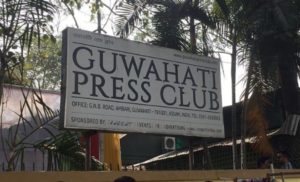NE UpdatesAnalyticsBreaking News
Dreaming of a vibrant media complex in Guwahati, writes Nava J. Thakuria


April 1: As the number of professional journalists, associated with various newspapers, news channels, radio outlets, digital platforms, etc is increasing rapidly in Guwahati, the virtual capital of northeast India and an emerging city with strategically importance for southeast Asian nations, they definitely need a wide space for interactions with no prejudice and trepidations. At the same time, millions of news consumers in far-eastern region of the country also deserve a place to make the media abusers accountable for their unprofessional works.
 Nearly one thousand working journalists of the city have been demanding for decades a permanent place with necessary infrastructure along with minimum facilities, where the media persons can assemble, discuss and resolve issues related to the medium. One can only expect, the government would take a positive stand over the matter and go for a media complex/ conclave/ campus in a prime location of the prehistoric city.
Nearly one thousand working journalists of the city have been demanding for decades a permanent place with necessary infrastructure along with minimum facilities, where the media persons can assemble, discuss and resolve issues related to the medium. One can only expect, the government would take a positive stand over the matter and go for a media complex/ conclave/ campus in a prime location of the prehistoric city.
Primary need of the complex will be an auditorium with around 1000 capacities with the modern sound system and other technology-oriented equipment. The multi-story auditorium should be ready for a video conference any time, where it can host important personalities like foreign country heads, acclaimed authors, illustrious journalists, etc.
 For the physical presence of an individual with utmost socio-political importance, the auditorium should fulfil the security needs (like separate entry/exit, lift, lobby with refreshing room, etc). Along with the press conferences, the auditorium may be used for regular training and orientation programs for the journalists (precisely the novice scribes from different parts of Assam) to understand new trends of the media world and its sustainability with credibility.
For the physical presence of an individual with utmost socio-political importance, the auditorium should fulfil the security needs (like separate entry/exit, lift, lobby with refreshing room, etc). Along with the press conferences, the auditorium may be used for regular training and orientation programs for the journalists (precisely the novice scribes from different parts of Assam) to understand new trends of the media world and its sustainability with credibility.
 The complex should also include a sophisticated media centre with a sufficient number of internet connected computer sets where the journalists would work according to their convenience. A good number of deluxe as well as economically viable lodging arrangements for the visiting journalists from different parts of Assam/ Northeast/ India and also outside the country will also be needed. Another essential addition should be a restaurant/ canteen, where the journalists and their well-wishers can hang out in a dignified ambience and pass quality time. No doubt, necessary parking space will have to be made inside the campus.
The complex should also include a sophisticated media centre with a sufficient number of internet connected computer sets where the journalists would work according to their convenience. A good number of deluxe as well as economically viable lodging arrangements for the visiting journalists from different parts of Assam/ Northeast/ India and also outside the country will also be needed. Another essential addition should be a restaurant/ canteen, where the journalists and their well-wishers can hang out in a dignified ambience and pass quality time. No doubt, necessary parking space will have to be made inside the campus.
Press Information Bureau, official media organ of the Union government in New Delhi may also be approached to have an area office in the complex, where various issues relating to north-eastern journalists can be resolved amicably.
 The complex may give space to all north-eastern States to showcase their tourism destinations (or any attractions they prefer) in separate chambers. DoNER ministry (responsible for development of north-eastern region)/ North Eastern Council may also be approached for using the space for pragmatic media communications. The entire complex should be designed with the concept of energy efficiency, where the sunlight, natural air-flow and open space would get due privileges. Adequate solar power generation and rain water harvesting arrangements should exhibit the entire complex as a new model of buildings/apartment/campus in the country.
The complex may give space to all north-eastern States to showcase their tourism destinations (or any attractions they prefer) in separate chambers. DoNER ministry (responsible for development of north-eastern region)/ North Eastern Council may also be approached for using the space for pragmatic media communications. The entire complex should be designed with the concept of energy efficiency, where the sunlight, natural air-flow and open space would get due privileges. Adequate solar power generation and rain water harvesting arrangements should exhibit the entire complex as a new model of buildings/apartment/campus in the country.
 As the media fraternity has incredibly increased its members with the inclusion of news portals, a media grievance redressal unit should also be planned inside the complex. Needless to mention that digital platforms are yet to be recognised as mainstream media outlets in India, but those outlets have been engaging a number of experienced journalists (who had either resigned from their traditional workplaces or were forced to leave) and hence those journalists should not be ignored for any reason. The social media platforms have empowered non-media users to a larger extent, but they too need accountability against the misuse and abuses. Once a redressal unit is established, the common people can complain there against any scribe or media outlet, which does not follow the Constitution of India and laws of the land. While self-regulation has been emphasized all the time for the professional journalists, the redressal forum would remind them to think about necessary introspections aiming to maintain transparency and accountability in the profession.
As the media fraternity has incredibly increased its members with the inclusion of news portals, a media grievance redressal unit should also be planned inside the complex. Needless to mention that digital platforms are yet to be recognised as mainstream media outlets in India, but those outlets have been engaging a number of experienced journalists (who had either resigned from their traditional workplaces or were forced to leave) and hence those journalists should not be ignored for any reason. The social media platforms have empowered non-media users to a larger extent, but they too need accountability against the misuse and abuses. Once a redressal unit is established, the common people can complain there against any scribe or media outlet, which does not follow the Constitution of India and laws of the land. While self-regulation has been emphasized all the time for the professional journalists, the redressal forum would remind them to think about necessary introspections aiming to maintain transparency and accountability in the profession.
Finally and most importantly the complex should give space to the city-based press clubs, recognised journalist associations, media house owner-editors’ forum, etc to run their offices independently. The beneficiary organisations may be levied with a nominal amount of money for overall maintenance of the complex. Leaving aside the government support from time to time, the managing committee should generate funds for its own survival. Its management board should incorporate representatives from the information & public relations department, civil administration, police authority, medical-engineering-environment sectors along with the mainstream media outlet owners, editors, reporters, news-desk employees, photo-visual journalists, media columnists, etc. Any organisation, which runs its office from the complex, may opt for a bigger campus as and when it feels necessary, and there should be no bar for members of the particular organisation to generate resources for their expected project.
 While the proposed complex will nurture the long pending expectations for hundreds of honest, dedicated and committed journalists to have an autonomous institution with the mandate to promote professionalism and excellence in journalism, it will also help Gauhati Press Club along with other media organisations to have a permanent address. The said press club, which is functioning from the Ambari archaeological site, needs to be shifted so that the richest archaeological site can be accommodated for necessary preservation and research works. Situated in the heart of Guwahati (under Kamrup-metro district), the site has been excavated several times since 1968 to find more archaeological remains. Discovered in the course of constructions for the Reserve Bank of India’s office in the locality, the site attracts visitors from different parts of the country. The archaeology department claims that the ruins of Ambari reflect the period of Sunga-Kushana dynasty. It continues sending letters to the press club committee to leave the site as well as the district administration to take necessary actions, but in vain.
While the proposed complex will nurture the long pending expectations for hundreds of honest, dedicated and committed journalists to have an autonomous institution with the mandate to promote professionalism and excellence in journalism, it will also help Gauhati Press Club along with other media organisations to have a permanent address. The said press club, which is functioning from the Ambari archaeological site, needs to be shifted so that the richest archaeological site can be accommodated for necessary preservation and research works. Situated in the heart of Guwahati (under Kamrup-metro district), the site has been excavated several times since 1968 to find more archaeological remains. Discovered in the course of constructions for the Reserve Bank of India’s office in the locality, the site attracts visitors from different parts of the country. The archaeology department claims that the ruins of Ambari reflect the period of Sunga-Kushana dynasty. It continues sending letters to the press club committee to leave the site as well as the district administration to take necessary actions, but in vain.
Need not to clarify that Gauhati Press Club today does not enjoy the privilege of representing all professional journalists in the city, rather the present committee faced serious allegations of facilitating media space to a banned armed militant leader. A police complaint was also lodged against the present press club president and secretary for initiating a virtual press briefing with the Ulfa military chief last year.
The State government in Dispur should serve the purpose of all professional journalists and it will not be fulfilled with allocation of resources to Gauhati Press Club alone. It can adopt a firm policy where the Ambari site will be made encroachment-free as well as the entire media fraternity would own a modern media hub dedicated to uplift their professional excellence very soon.
The author is a northeast India-based media activist





